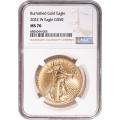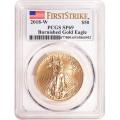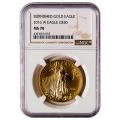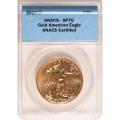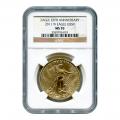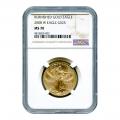Certified Burnished American Gold Eagles

A term that was introduced recently, in 2006, "burnished" refers to where and how the American Gold Eagle was minted. All Burnished American Gold Eagles sport a "W" mint-mark, signifying its place of origin: the West Point Mint. Celebrating the successful 20th anniversary of the American Gold Eagle series, the US Mint released a new coin to join the record-breaking program. A burnished coin was produced for each size variety (1 oz, 1/2 oz, 1/4 oz, and 1/10 oz), but switched to only minting 1 oz coins in 2009, due to a stall in proof and burnished Gold Eagle production.
Production of the Burnished American Gold Eagle
The US Mint claims that the actual process of minting the burnished coins is very similar to the proof version but the outcome is quite different. Burnished coins greatly resemble brilliant uncirculated Gold Eagles, wherein they carry that same frosted finish, instead of a glossy one. The complicated and precise process begins with a blank put through a spinning drum. When that blank comes out, on the other end, a specialist handles the coin with white gloves to ensure maximum care. The coin is then placed, by hand, into the coin press, where a high pressure strike is released. This gives the burnished coin a more refined look, making every little detail sharper. Although the finish, of the burnished coin, has a matted look, the background is more mirror-like, giving the illusion that Lady Liberty is floating.
Certified or Non-Certified
One of the most common questions we are asked is: what is the difference between Certified and Non-Certified coins. The most obvious difference is how the coin is packaged. Non-Certified coins usually do not come in any packaging or they come in their originally issued packaging, such as the Proof Gold Eagles come in their presentation boxes. Certified coins are placed in airtight, official holders, marked by the grade they received and the name of the certifying grading agency. Since Certified coins' condition is more specified than a Non-Certified coin, their value can greatly increase. Collectors and numismatists appreciate Certified coins since most of the work is done for them and they can just reap the benefits of owning a Certified coin.
Certification Terms
Learning about the Sheldon Numeric Scale isn't necessarily a priority for investors but can deem useful when looking to purchase Certified American Gold Eagles. Dr. William Sheldon was an American psychologist by trade and a numismatist as a hobby. In 1948, Sheldon developed the Sheldon Numeric Scale, which became the foundation of grading and certifying coins. The Sheldon Numeric Scale dictates that a coin's condition can fall between 1 and 70. Before this groundbreaking system, coins were graded mostly by physical appearance and could receive one of three grades.
When purchasing a Certified American Gold Eagle, there is information provided on the coin holder that is important to know.
- MS: Short for "Mint-State;" refers to coins that have never been in circulation and are the same condition as when they were originally produced. Mint State coins will receive a grade ranging from 60-70 on the Sheldon Numeric Scale.
- SP: A "specimen" coin is a combination of strike type (somewhere in the middle of Mint State and Proof).
- MS/PF70: Bullion coins that have kept their original mint luster and contain zero post production flaws.
- MS/PF69: Bullion coins that contain 2 or less minute imperfections but still carry their original mint luster.



